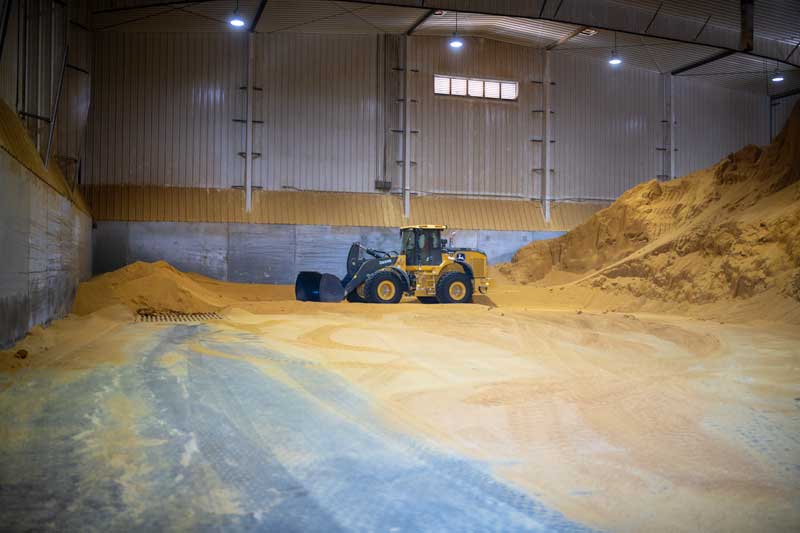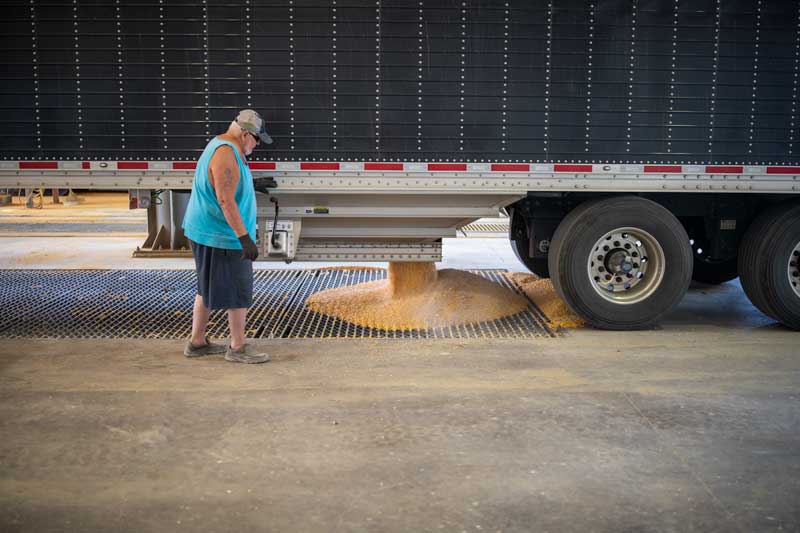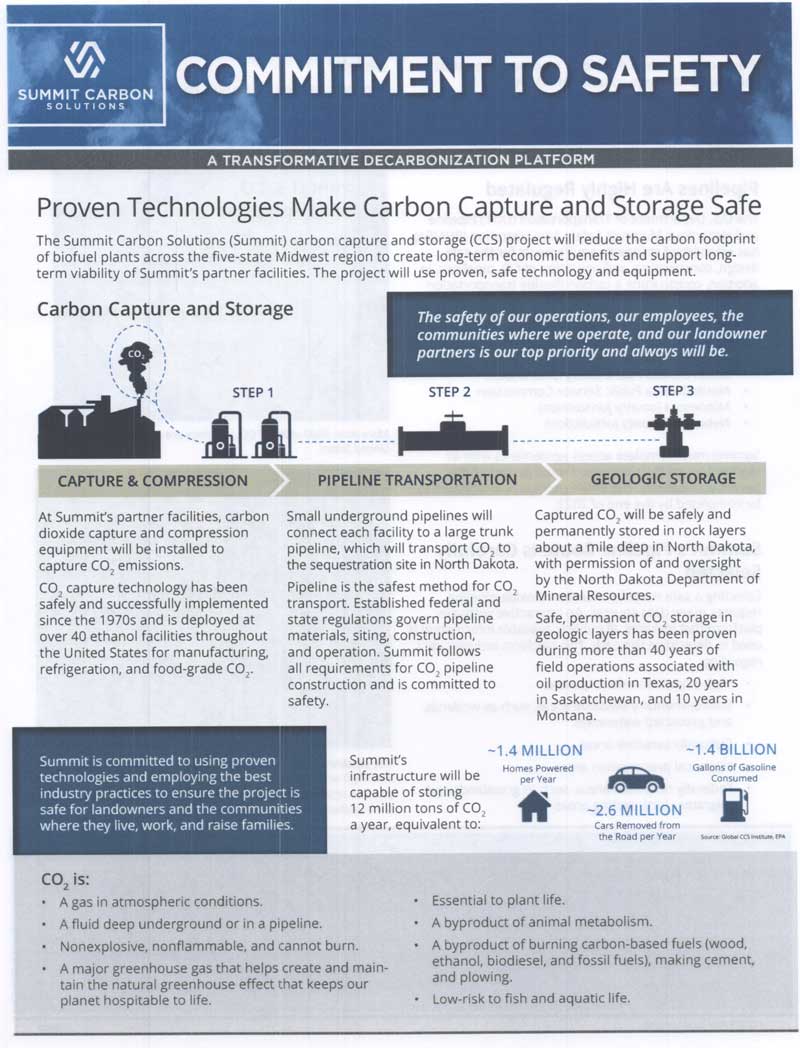This week Glacial Lakes Energy and Summit Carbon Solutions held a media day to answer questions and give reporters and elected officials a chance to learn more about ethanol production facilities, and the challenges that renewable energy producers face in reducing their carbon footprint for an industry that provides a active market for agriculture production while exporting hundreds of millions of gallons of ethanol annually from South Dakota.
State Legislators from Districts 1, 3 and 25 were in attendance with county officials from the region for the event at the Glacial Lakes Energy facility just outside of Mina, South Dakota, where organizational representatives provided an overview of the Mina facility, one of four operating (Aberdeen, Mina, Watertown & Huron) under the Glacial Lakes Energy group. The Mina facility currently takes in 35 million bushels of corn annually to produce 100 million gallons per year, with Aberdeen producing approximately 49 Million gallons of ethanol, Huron 33 Million, and Watertown producing 100 Million Gallons of Ethanol annually.
Staff from Glacial Lakes Energy provided a tour of the facility, which provided a sense of the immense scale of the project. Below, you can see images as participants viewed the dry distiller’s processing building where dried distillers grains (DDGs) have emerged as a key ethanol co-product. As part of the presentation, staff noted that they have had to expand to keep pace with production, as during one inclement winter, weather prevented regular loads from being hauled away as scheduled, and they had to shut down production due to filling the building to capacity.


The tour also took participants into the area where grains are off loaded, with a constant stream of trucks feeding production.

Glacial Lakes CEO Jim Seurer explained further about the operation, and why it their participation in the Summit Carbon pipeline is important for reduction of their carbon score:
Presently, as a by-product of ethanol production, carbon dioxide is scrubbed at their facility, and after processing, released back into the carbon cycle, including into the atmosphere. Seurer noted that one of the challenges South Dakota Ethanol producers face is that as an exporter of energy, partners in some states are seeking sources with a lower CI (Carbon Index) score as part of their production process. While they can change some of their equipment out, and move the needle a few points, the Summit Carbon Pipeline will more than double the impact of removing Co2 in comparison to current scrubbing methods, reducing the environmental impact and keeping access to those markets who are increasing their standards for being carbon neutral.
As noted, participating with the Summit Carbon Solution pipeline allows them to reduce their carbon footprint by locking the Co2 into geologic storage, as explained by the fact sheet from Summit Carbon Solutions:

Benefits on the Summit Carbon Solutions Pipeline Project were explained by Summit Carbon’s Chief Commercial Officer Jim Pirolli:
Biggest takeaways from the presentations for me were the scale of the economic development that ethanol production has provided in the state, and will continue to provide with 11,000 jobs being added for pipeline creation.
As part of the Summit project, they currently have over 160 miles of pipeline easement already done in South Dakota, with over 300 state landowners who have signed on of about 800 landowners total, for a project that benefits the entire midwest, with 32 ethanol plants across 5 states participating in the project.
The word I’m hearing from those involved in the project is that they anticipate that they are on track to have a majority of South Dakota landowners sign on by the end of the year, and possibly even more checking off the box to allow the project to move forward by that time.
Unfortunately, there seems to be the same resistance to any development of our energy resources in the state, such as with coal and wind energy. It’s a troubling trend where any efforts at energy production, where renewable energy projects are being fought as hard as sources such as coal and oil. If we want cheap and reliable energy for our homes and our vehicles, we need to encourage the development of our domestic resources.
As we seek to expand access to those traditional and renewable sources of energy, ignorance is the enemy of progress. That’s why outreach efforts such as this one from Glacial Lakes and Summit Carbon are important. The more the public is educated about what they do there, and why they’re moving forward, the brighter our state’s future can be.

Climate hoax
From your pocket to theirs.
more kudzu. That’s what we need,more Kudzu.
Grow it,cut it down and bury it deep underground.
This is a fascinating take.
Mine?
We have starving people in San Francisco and here we are burning our food.
I can’t tell you how good it feels to put pure 91 octane in our car, and triple purified water in my body.
My core questions that may make the ethanol proposal stronger:
Exploration of ethanol should be happening in the research phases at the moment. Like wind, what happens in years when the foundation of the supply chain gives out (wind and rain and the root level inputs for windmills and distilleries)? What happens if *gulp* Russia stops producing fertilizer or we run out of a way to recharge the soil? Are dandelions nature’s natural nitrogen fixers? Are there economic inputs/outputs being ignored in the plans that make them look more viable (similar to the externalization of damage to water resources in the Black Hills from international mining operations like Gilt Edge)?
I think it’s great that we’re pursuing projects like this, but sometimes I feel like we need to be more conservative when moving from concept to scale.
Constructive criticism is the best tool for sharpening the edge of an idea.
Sincerely,
John
It all depends on getting Hugh tax breaks and using eminent domain. Taking the use of the land and getting your tax dollars.
Greenwashing
More money for ethanol plants. More money for farmers and landowners. More jobs. More tax dollars for SD. A pipe is the plan and I support that. I’m glad to see SD taking a lead in the future of carbon reduction.